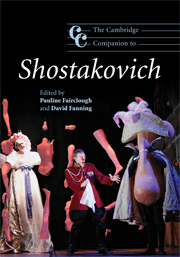Book contents
- Frontmatter
- Introduction
- PART I Instrumental works
- 1 Personal integrity and public service: the voice of the symphonist
- 2 The string quartets: in dialogue with form and tradition
- 3 Paths to the First Symphony
- 4 Shostakovich's Second Piano Sonata: a composition recital in three styles
- 5 ‘I took a simple little theme and developed it’: Shostakovich's string concertos and sonatas
- PART II Music for stage and screen
- PART III Vocal and choral works
- PART IV Performance, theory, reception
- Notes
- Select bibliography
- Index
4 - Shostakovich's Second Piano Sonata: a composition recital in three styles
from PART I - Instrumental works
Published online by Cambridge University Press: 28 September 2011
- Frontmatter
- Introduction
- PART I Instrumental works
- 1 Personal integrity and public service: the voice of the symphonist
- 2 The string quartets: in dialogue with form and tradition
- 3 Paths to the First Symphony
- 4 Shostakovich's Second Piano Sonata: a composition recital in three styles
- 5 ‘I took a simple little theme and developed it’: Shostakovich's string concertos and sonatas
- PART II Music for stage and screen
- PART III Vocal and choral works
- PART IV Performance, theory, reception
- Notes
- Select bibliography
- Index
Summary
Since composers in the Soviet Union were routinely urged to devote themselves to increasing the production levels for the officially sanctioned mass genres of patriotic cantata, opera and programmatic symphony, Shostakovich had little professional incentive to compose chamber and solo works. But as all artistic celebrities come to realize, inattention can spell relief and freedom for creativity and the artist's conscience. While it would be simplistic to claim that Shostakovich's smaller-scale compositions are more personal, more revelatory, let alone superior to his symphonies, it is nevertheless certain that most were written with a different kind of performance and performer in mind. Following a notable Russian precedent, Shostakovich routinely released new works of this sort that were not dedicated to the ‘tsars, kings, and emperors’ of the world, nor to his inescapable employer and patron – the Soviet State – but to individual musicians, living or dead, who had attained a level of artistry commensurate with the music's demands.
Leonid Nikolayev: pianist, composer, pedagogue
Shostakovich dedicated his Second Piano Sonata to a Conservatoire mentor whom he revered throughout his career: Leonid Vladimirovich Nikolayev (1878–1942). Begun in early 1943, just four months after Nikolayev's death in Tashkent, this sonata stands apart from later works dedicated to Rostropovich, Oistrakh and the Beethoven Quartet when they were quite active as performers. In style as well as the circumstance of its composition, the Second Sonata encourages a retrospective glance back to the 1920s, when Nikolayev was the renowned head of the Leningrad Conservatoire's piano faculty, Shostakovich was a precocious multi-talented student, and all of the musicians of post-revolutionary Russia were struggling to establish an identity for themselves and a relationship to the past, present and future.
- Type
- Chapter
- Information
- The Cambridge Companion to Shostakovich , pp. 95 - 114Publisher: Cambridge University PressPrint publication year: 2008

